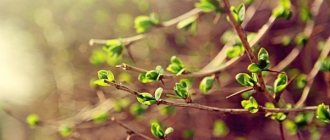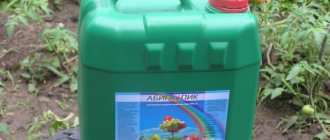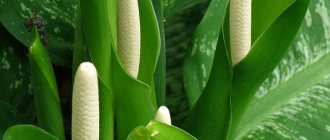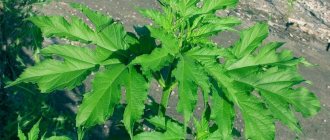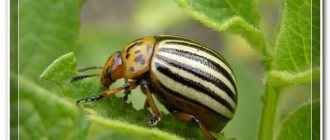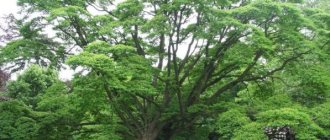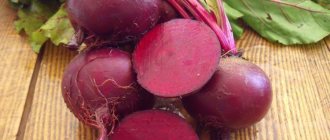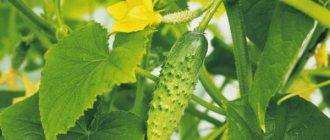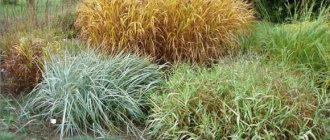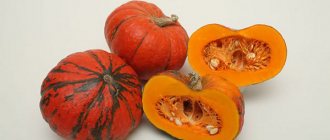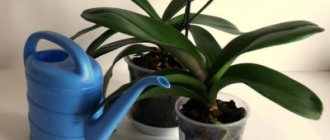Basic Concepts
Growing season
This period will vary for certain plant species and varieties.
A purely biological term that characterizes each plant separately. The growing season is a certain time period during which the plant goes through the active period of its growth. For example, for early ripening cucumbers the growing season is 95-110 days.
If we are talking about perennial plants, such as apple trees, pears, plums, etc., then their growing season begins as soon as the flower buds begin to swell, and this period ends with the leaves falling in the fall. Further, in winter, there is an inactive phase of tree growth - this is no longer a growing season. However, if you properly care for the plant in winter, you can speed up its growing season, we will talk about this later.
The growing season for trees in tropical and equatorial climate zones follows a slightly different scenario. For example, the growing season of a banana tree is considered to be the following time interval: from the beginning of flowering to the harvesting of fruits. After this, although the tree remains green, it is temporarily out of the growing season.
Growing season
This term covers all plants of a certain climate zone. We will talk about all the plants for our zone, what the growing season of fruit trees is and how to determine it, as well as the growing season of some vegetable crops.
The annual life span of perennial plants can be divided into four periods:
- Vegetative growth;
- Transitional autumn;
- A period of relative rest;
- Transitional spring.
For perennial plants in our climate zone, these periods are repeated every year. The growing season covers only three points from this list: 1, 2 and 4. The winter period is not considered to be a growing season. The 4 point time interval may start with a slight delay, or, conversely, earlier than it should.
It all depends on when the real spring warmth begins, when the snow and night frosts go away. The temperature required for the start of normal growing season in plants differs for each species or variety. For example, the growing season for an apricot tree begins earlier than for a cherry or pear. But it is generally accepted that for the beginning of the growing season the air temperature should be at least +5 ºС. This applies not only to fruit trees, but also to vegetable crops.
It is worth noting that the growing season of annual vegetable plants is still different. It is generally accepted that the beginning of this process is the rising of the seeds, and the end is the drying of the plants. But some plants bear fruit several times during a warm period of time, then this period can be considered from the beginning of the appearance of flowers until the fruit fully ripens.
The duration and period of the growing season, what factors influence their duration
The term and period are influenced by climatic conditions, so each zone has its own indicators. Due to bad weather conditions, the fruits on the plants do not always have time to ripen, so it is necessary to reduce the time frame and harvest ahead of schedule.
In warm and good weather, some plants are able to bear fruit several times per season. Such a favorable climate accelerates the process and allows crops to grow and develop at maximum speed.
The length of time is also influenced by the type of vegetation; for some crops it can last more than a year, for others - several months.
Professionals noted that each type of vegetation has phases that allow the plant to prepare for changes.
For example, closer to winter, growth stops and a phase of slow development begins, but by spring the vegetation is ready for active growth, the crop wakes up.
The length of daylight also influences the process. The longer the day, the more active the growth, this especially affects vegetables and berries.
After flowering, perennial crops spend all their energy collecting nutrients, so fruit ripening does not occur as quickly as we would like. Trees spend a lot of time preparing for the next season and winter time; at this stage, the plants feed and accumulate energy.
If we talk about the timing of the growing season, then this interval does not always begin the same.
The following factors influence this:
- humidity;
- night frosts;
- when the snow melts;
- when the first warmth comes;
- feeding and nutrients.
If one of these factors is missing, a delay occurs. To begin development, the temperature must be at least plus five degrees; this is the optimal regime for all crops in our zone.
Is it possible to determine the growing season?
The growing season of different species and varieties of plants is very different and cannot be placed within a certain framework. It is generally accepted that this period can last from three days to three months. But plants are always influenced by various factors:
- soil condition;
- weather;
- heredity factor;
- various diseases and pathologies.
Depending on these factors, the growing season may vary in time. Sometimes it can go up to nine months! Many crops in our climate zone do not have time to fully ripen, and they are harvested earlier, since there is no time left for ripening. Then it is said that the growing season ended incorrectly.
But there is still a way to determine the growing season of plants and understand what it really is. For example, when you buy a bag of seeds, it must indicate the growing season, its beginning and end. As for fruit trees, we have already said that the beginning is when the buds swell, and the end is when the leaves fall. For example, the growing season of some potato varieties begins from the moment the sprout germinates, and ends when the plant dries completely and the potatoes can be dug up.
The growing season of horticultural crops. Conditions affecting the duration of the growing season
Beginning gardeners who have little or no experience in caring for vegetables and fruits and berries will first of all encounter the term growing season. In this article we will look at this concept and also tell you how to care for plants at this time.
Definition of the word "vegetation"
Each plant has its own development period, from planting seeds to harvesting. This stage is called the growing season. Depending on climatic conditions and territorial location, this time period may vary with a difference of 2-3 months. For most plants, the growing season begins in spring and ends in autumn. These are mainly annual crops that are sown in April. They are harvested either once in the fall, or several times during the period under consideration. There are also plants that are sown in the fall, their development is interrupted in winter, and they continue to grow in the spring. In fruit-bearing crops, the growing season begins with the swelling of the buds in the spring and until the fruit ripens. Then comes the resting phase.
Vegetation cycle of fruit plants
In areas with a temperate climate, the growing season for plants begins in April. The same thing happens with fruit bushes and trees. The buds of gooseberries and currants begin to swell first - around the tenth of the month. After at least a week, the flower buds open. In addition, flower ovaries appear earlier than vegetative buds, which in turn will open in 5-6 days. For plums and cherries, the period begins on April 12-20. In 10 days, the flower buds will swell and bloom. Fruiting buds will bloom in a week. The latest period of the growing season begins with the apple tree.
Factors influencing the development time of horticultural crops
By reading the article, we found out what the growing season of plants is. Next, let's look at what affects the duration of the period under consideration.
Surely you have noticed that each region of Russia is famous for its varieties of vegetable and fruit crops. The country's territory is quite wide, and certain plant species cannot coexist in all regions. The first factor influencing the duration of growth of various crops is the territorial location. For example, heat-loving plants in a cold climate will take much longer to mature than those in a temperate or warm location. In this regard, a new factor arises - the temperature environment. The lack of heat in the northern regions does not allow the cultivation of certain types of crops, such as eggplant, peppers, melons and others. Also, the fruiting period depends on the length of the day. In areas where there is less daylight, the growing season lengthens. Other equally important factors are plant care, soil composition, aeration and the amount of fertilizer added to the ground.
Potato ripening time
Since planting and harvesting dates may shift under the influence of various factors, it would be wise to select suitable varieties. For example, the growing season of potatoes, depending on the type, ranges from 50 to 110 days. Therefore, when choosing a variety, it is worth taking into account the ripening period, taste characteristics, as well as resistance to a long storage period.
In spring, planted tubers germinate in 12 days. After 15 days, the first shoots appear. But under unfavorable weather conditions, this period can last up to 40 days. It takes approximately 30 days before the potato blossoms.
After this, the plant begins to form tubers. After 20-25 days, the tubers increase to their maximum size.
syl.ru
How does the growing season progress in different crops?
For different crops, the growing season occurs in different ways (we already talked about what it is and how this term differs from the growing season).
Growing season of some vegetable crops:
- The growing season of potatoes takes on average 110 – 130 days. This is an average, as there are early, medium and late potatoes. This period begins with the germination of the sprout. Then comes the period of pollination and flowering. After this, small “green apples” appear on the green bush, which under no circumstances should be eaten. When the plant dries out, the growing season ends and the crop can be harvested.
- The growing season of early-ripening cucumbers takes 95-105 days, and of late-ripening cucumbers - 106-120 days. It may take 25-45 days before the cucumber bush begins to flower, after which the bush begins to bear fruit. And for the last two months of the growing season, the plant continues to bloom and at the same time bear new fruits. After this, it dries out in early autumn, and this period ends.
- The growing season of tomatoes (many people say this, although it is correct to say “the growing season of tomatoes”) is very similar to the same period of cucumbers. Only the time frame is slightly different, since tomatoes are divided into the following types: early ripening - 55-75 days, early ripening - 76-95 days, mid-ripening - 95-110 days, mid-late - 111-120 days and late - 121-135 days.
- The growing season of cabbage lasts from 3 to 6 months, depending on the plant variety.
Spraying peach against diseases
In the conditions of Belarus, on dwarf and semi-dwarf rootstocks with distances between trees for an apple tree of 1.5-2 m, for a pear tree - 2-3 m, the most acceptable form is a free (or classic) spindle (Fig. 1). In this case, the formed tree should have a trunk 60-80 cm high, a strong central conductor and lateral shoots extending evenly from the trunk with wide (60-80°) departure angles.
Optimal period for processing
The first spraying in early spring against insects wintering in the bark should be carried out using a watering can with large holes. Thus, we supply the maximum volume of solution to the plant, simply pouring it in so that water can get into even the smallest cracks without having time to be absorbed or evaporate, and at the same time killing all parasites.
Spring
fungicide preparations “Abiga-Pik”, “Gaupsin”, “Planriz”, “Skor”, “Trichodermin”, “Khoruz”, “Tattu”. They are used in the fight against most fungal infections;
Autumn treatment is required to suppress the proliferation of fungal spores, because in the fall the most favorable conditions for the development of fungi are formed - high temperature and humidity. If you do not treat it in the fall, then in the spring the tree will be greeted by millions of new fungal spores that have spread throughout all branches, and fighting them will require significant effort, money and time. Therefore, you should not skip autumn - treatment at this time is very important and is done for the future. The goal The procedure is carried out in several stages with an interval of 3-4 days. They use fungicides based on copper-containing preparations (Bordeaux mixture, copper sulfate) as well as solarium emulsion.
If cultivation is aimed at producing greens, roots or stems, gardeners stimulate growth while slowing down the fruiting process. This technique is effective in the process of growing potatoes, cabbage and other garden crops. This is due to the fact that in such plants, at the flowering stage, the fruits begin to become coarse and lose their taste. The same thing happens with perennial garden crops, which are recommended to be stored in a cool room during the cold season. This condition will ensure an active flowering process, suppressing their growth. Slowing growth will allow you to preserve the harvest of cabbage, potatoes and other vegetables better and longer.
I would like to note that the growing season for fruits, including apple trees, begins in the spring, when the buds bloom on the trees.
But what is the growing season? This is the name for a certain period of time during which the active development of plants takes place, taking into account the climatic conditions of the region.
Vegetation in Russian means the growth of stems in length, that is, it must be sprayed before the period of flowering and fruiting. Vegetation in a different way increases green mass
Summer
The cuts are made on the outer buds, but if the branch has deviated downwards or to the side, it is shortened above the bud that will shoot in the required direction (Fig. 6). The competitor of the conductor (the uppermost lateral branch, located at a very acute angle and rivaling the conductor in terms of growth force) is cut into a ring, that is, completely removed. The trunk conductor is cut so that it rises 15-25 cm above the branches.
Autumn
Third or fourth year. The trees are formed in the same way as in the second year, bringing the guide to a height of 2-2.5 m and maintaining the cone-shaped shape of the crown. The lower branches are allowed to grow until they fill the space allotted to the tree. Be sure to remove strong branches that upset the balance in the crown, have sharp angles and cannot be bent. In the upper part of the crown, the development of competitors to the conductor or branches with sharp angles of departure is not allowed. The lower shoots (first tier) are given the opportunity to grow until the space allocated for the tree is filled. If necessary, they are thinned out, first of all removing low-growing ones to increase the height of the trunk (Fig. 4).
In the lower part of the crown, permanent branches of the semi-skeletal type should be formed, above - fruit-bearing ones, no older than 3-4 years of age. The lateral branches at their origins should be approximately half as thin as the conductor. In this way, a crown is formed that has the outline of an elongated cone with a width at the base of 1.2-2 m. Thanks to this, the tree makes good use of sunlight, which contributes to the formation of generative (fruit) buds, intensive fruiting and the formation of a high-quality fruit crop. It is worth that gardeners often use comprehensive measures to combat pests, spraying peach orchards with a mixture of fungicides and insecticides, which kills both fungal parasites and insects equally well. Also, do not spray with the same preparations - pests quickly adapt. Use different chemicals - the choice of samples offered on the market is quite large.
What to spray - preparations
insecticide preparations “Aktara”, “Enzhio”, “Aktellik”. The drugs are used against a variety of insect pests;
- It is worth noting that the start of the first, spring processing depends on the region where the peach grows.
- Please note that during this period you should not use urea-based drugs. Since it contains nitrogen, which is an active stimulator of vegetation. If such drugs are used before the buds begin to open, they will speed up the plant’s emergence from dormancy, “waking up” it ahead of time, which can lead to disruptions in the further development of the tree, including loss of harvest.
- Every gardener should know all these subtleties in order to be able to properly regulate the growing season of plantings. After all, this is the key to a bountiful and high-quality harvest in the future.
- The duration of this process in an apple tree is affected by temperature and daylength, which is determined by the region where the trees grow. The intensity of growth and development of an apple tree will depend on many factors - the plant variety, its agrotechnical characteristics and natural factors. Each breed of fruit and berry plants, including apple trees, has its own phenophases that occur at different times. Their changes are affected by temperature, air humidity level, etc.
- Often, harvesting in the garden occurs before the seeds ripen. In some cases, the fruit may not even ripen. For tomatoes, cucumbers and other vegetable crops that produce several harvests, it is necessary to determine the time of the first and last harvest. This will allow us to correctly characterize this concept.
- Vegetation - the state of active life of a plant, its growth and nutrition
Processing technology
Fig. 6. Pruning of low-growing trees is best done during the dormant period. By this time, the active processes of shoot growth have ended and a significant part of the nutrients moves to the roots, trunk and skeletal branches, where they are deposited in the form of sugar, starch and fats.
In the fourth year, as a rule, crown formation ends. After this, it is maintained in the dimensions determined by the planting scheme. In a spindle-shaped crown, none of the branches should be stronger than the conductor. In order not to activate growth processes, shortening annual growth should be avoided. Long branches that extend beyond the allotted space are shortened to fruitful wood or to an annual ring. The crown must be lightened in every possible way, cutting out strongly growing vertical shoots.
I would like to draw the attention of both professional gardeners and amateurs to the fact that the key to successful fruiting is a correctly formed crown of the fruit tree in the first 3-4 years.
The ability to start spraying on time by choosing the right preparations can save your peach from death. And knowing the rules of spraying will save you from unnecessary financial expenses for re-purchasing drugs and will help ensure that the peach crop is harvested on time and in full.
diesel fuel emulsion. An effective remedy against insects. If a plant is sprayed with such a mixture, it will become covered with a film that blocks the access of oxygen to various insects hibernating in the bark, causing them to either crawl out or die;
Video “Spraying a peach”
In the southern, warm regions, spraying begins in mid-March, but the further north you go, the start date for the procedure moves closer to April - it all depends on the average air temperature, which should not fall below +4 degrees Celsius. Further spraying is carried out based on observation of the growth and development of the tree - the beginning of the growing season, the appearance of the first foliage, buds, fruits.
plodovie.ru
Spraying during this period also helps in the fight against curl, the most dangerous enemy of the peach orchard. The spores of the fungus overwinter and then reproduce on leaves sprouting from the buds, turning them brown. Young leaves curl, dry out and fall off. As a result, the tree grows worse and does not bear fruit. The same copper-containing preparations help well against this fungus.
Peach is a capricious tree and requires constant attention from the gardener. But if you take proper care of it and carry out agricultural practices in a timely manner, you will be rewarded in the form of juicy large fruits, because the peach is one of the three most delicious fruits in the world, along with orange and mango. But in order to taste the harvest, it is necessary to protect the delicate tree from external enemies: diseases and parasites. The article will tell you when and what kind of processing is necessary for your peach to cope with enemies and produce a harvest.
U
In fact, the growing season for each crop is a variable value. Its change can be influenced by many factors related to the characteristics of the variety and the growing environment. In this regard, it can last from several days to three months. With a lack of nutrients, good lighting and heat, this process can take an order of magnitude longer - up to 9 months. Vegetation is directly related to the process of growth and development of plantings, although these two concepts are significantly different from each other.
Look out the window, Svetochka. You see, after winter, sleeping trees woke up, stretched, opened their buds, put out leaves - this is the growing season: a period of active plant growth! Spray now, as there are pests that can damage the flowering tree.
Is it possible to shorten the growing season and how to do it?
A shortening of the growing season is when a plant goes through the entire growing season faster than in the generally accepted time frame. Many gardeners often ask similar questions, because everyone goes out to try fresh cucumbers and tomatoes earlier than they should.
To do this, you need to start sowing seedlings in February. Many sow seeds in small boxes and place them on the windowsill, and some create special greenhouses. All of these methods are great if you want to grow vegetable crops, namely those that bear fruit.
But if you figure out what the growing season of cauliflower, Brussels sprouts and other varieties of cabbage is, it becomes clear that it does not bear fruit, in fact you eat leaves. Here we need a slightly different approach to shorten the growing season. In this case, it is worth increasing growth and slowing down the flowering process. This can be done through special preparations and fertilizers.
There is a third type of shortening of the growing season. Not everyone understands what the process of shortening the growing season of fruit trees means. To do this you need to care for the plant. In late autumn, trees need to be thoroughly watered with various mineral supplements. In winter, during severe frosts, you need to throw a lot of snow on the root system of the tree. Then in the spring it will begin to bloom earlier and more actively.
Now we have understood the growing season of various plants and understood what it is and how to manage this process. Finally, I would like to say that every gardener can have an excellent harvest if he takes this article into account.
The influence of irrigation on the growth of trees and shrubs
In some years, when the summer is very hot, tree growth is delayed. They lack moisture. If heavy rains suddenly begin in the second half of summer, then this is also not very good for the plant. Due to the abundance of moisture, trees and shrubs give a strong burst of growth, and it drags on. If the branches continue to grow, they will not be well prepared for the winter. We have already said what plant vegetation means. It involves the accumulation of nutrients, while the shoots must ripen. If this does not happen, the plant may die. Therefore, the goal of gardeners in the fall is to prevent secondary growth of shoots.
Barberry - benefits and harm to human health
Growing season: description of the concept, definition for various plants, timing
- October 9, 2018
- Gardening tips
- Ksenia Stepanishcheva
Among gardeners, the concept of a growing season is common. This concept presupposes a certain period for plants of the same climate. The growing season unites plants of a particular species or variety and determines the time of their activity. Each plant has its own life cycle with development phases. Gardeners and gardeners need to know the features in order to be able to manage these processes to improve yields. It is important to understand what vegetation is and at what time it occurs in different plants. This topic is covered in detail later in the article.
Reasons for slow vegetation
In general terms, the reasons for the slowdown in vegetation can be called an imbalance of factors that determine the normal development of plants. The most common reasons for slowing down the growing season is a violation of the temperature regime. Thus, hot summers have a detrimental effect on certain agricultural crops, which can cause a sharp reduction in yield. Frosts can also affect the slow development of plants.
Any lack of heat, water, light and nutrition can cause a malfunction in the formation and development of plants, which is why it is so important to monitor them, especially during the growing season.
Period
Plant growing season - what is it? This time varies for certain types and varieties of plants. This is a purely biological concept that characterizes each plant separately. The growing season is the time during which they go through an active period of growth. For example, for early-ripening cucumbers it lasts 95-110 days.
In perennial plants (apple trees, pears, plums), this period begins with the swelling of flower buds and ends with the falling of leaves in the fall. In winter, the inactive phase of tree growth begins - this is not a growing season. But if proper care is provided in winter, then it is possible to speed it up.
The growing season for tropical and equatorial trees follows a different principle. For example, in a banana tree it will begin with flowering and continue until the fruit is harvested. It will then remain green but still exit from that period.
What is the growing season in plants?
This period of time will be different for different types of vegetable and garden crops. This concept refers to the active growth of the plant, for a cucumber from 90 to 110 days. If we talk about fruit trees, then the vegetative period of a plant of this type begins with the swelling of the buds in early spring and ends in the fall, after the leaves fall. In winter, crops are in an inactive phase, so this period of time does not apply to the growing season.
Each known plant species has its own growing season.
If we talk about trees that grow on the equator or in the tropical zone, then their development occurs a little differently. Let's look at this using the example of a banana; the term in question takes into account the interval from the moment of flowering to the harvest of the first harvest. After harvesting the fruits, the tree remains green for a long time, but this period is not considered the vegetative period of the plant.
Growing season
The growing season of plants - what is it? This concept applies to all plants of a certain climate. The life year of perennial plants consists of the following stages:
- Vegetative growth.
- Transitional autumn.
- A period of relative rest.
- Transitional spring.
For perennial plants in Russia, these periods are repeated annually. The growing season includes only 3 points from this list: 1, 2 and 4. Winter is not considered a growing season. Time 4 points may be delayed or start earlier. This is determined by the beginning of spring warmth, when the snow and night frosts disappear.
Agrotechnical measures
The growing season of plants begins in mid-spring. All agrotechnical activities are associated with it. At this time, cultivated fruit and berry plants need additional care.
After winter, with the disappearance of the snow cover, all trees and shrubs live mainly due to the plastic material deposited in the root system and the ground part. It had been accumulating throughout the previous year. Many people mistakenly believe that in early spring plants feed on minerals in the soil. If the tree does not have enough nutrients, then it is not able to begin the formation of flower buds. Therefore, next year’s harvest may not be expected. To avoid this, it is necessary to apply fertilizers to the soil not only in spring, but also in autumn. This is very important for good fruiting.
Definition
The growing season is a time that differs for all types and varieties of plants. It is believed that it can last for 3 days to 3 months. It depends on the:
- soil conditions;
- weather;
- heredity;
- diseases and pathologies.
Depending on these factors, the growing season varies in time. In some cases it reaches up to 9 months. Many crops are unable to fully ripen and are harvested earlier because there is no time to ripen. Then they say that the growing season ended incorrectly.
But there is a method for determining this time. For example, bags of seeds indicate this period, its beginning and end. In fruit trees, this period begins with the swelling of the buds and ends with the fall of the leaves. In some types of potatoes, the growing season begins with the sprout sprouting and ends with drying, after which you can begin to dig up the root crops.
Growing season depending on plant type
The diversity of plant species on our planet is amazing. Various herbs, vegetables, berries, trees, shrubs - each representative of the flora has its own developmental characteristics. Vegetable and fruit crops are the most important for agriculture, so it is their growing seasons that are worth considering in more detail.
Vegetation of currants, raspberries and gooseberries
After winter, currants wake up early - the buds swell with the onset of spring. The speed of its development depends on the area of growth. Following the buds, after a couple of weeks, buds begin to form, flowering lasts no more than a week.
Raspberries begin their growing season at the end of March; the difference in varieties is not particularly important here. Raspberries bloom after a few months, the ripening of the berries ends in mid-summer.
The growing season of gooseberries begins earlier than other shrubs. After 3 weeks it blooms, and after two months the berries appear.
Growing season for fruit trees
Here it all begins with the swelling of flower buds, a week after them the leaf buds swell. Depending on the species, this period of trees has its own characteristics.
Apple trees begin to bud at 10 degrees outside the window. These trees bloom for a week and a half. They can bear fruit all summer, from July until late autumn, it all depends on the variety.
Already at six degrees above zero, pear trees begin to awaken. Two weeks after the start of the growing season, pears begin to bloom. With a sharp cold snap, the growing season may stop. A week or a few after flowering, the trees begin to bear fruit.
Plums fade in May, after which fruits form, the ripening of which ends by August or mid-September, depending on the variety.
Cherry is not so demanding on temperature conditions, care and soil composition, so its growing season begins in April and passes quickly.
In vegetables
Vegetation occurs differently in different crops. It is also different for vegetables:
- For potatoes, this period lasts 110-130 days. This is the average level, since the vegetable can be early, medium and late. The process begins with the germination of the sprout. Then comes flowering and pollination. Then “green apples” form on the bush. After the stems dry, the growing season ends and you can begin harvesting.
- The growing season for early-ripening cucumbers takes 95-105 days, and for late-ripening cucumbers it takes 106-120 days. It may take 25-45 days before the bush blooms, and then there will be fruits. In the last 2 months of the growing season, flowering continues, and new fruits still appear. And with the arrival of spring, the plant dries out, and this period ends.
- The growing season of tomatoes is similar to cucumbers. Only the period is slightly different, since tomatoes are early ripening (55-75 days), early ripening (76-95 days), mid-ripening (95-110 days), mid-late (111-120 days) and late (121-135 days).
- The growing season for cabbage lasts 3-6 months, it all depends on the variety.
Factors influencing vegetation
The growing season for plants of different species and varieties can vary significantly. Average values are considered to be from 3 days to 3 months. The timing depends on several factors, the main ones being:
- soil condition;
- climatic conditions;
- plant diseases and pathologies;
- heredity of cultures.
The climate in our country is not always favorable to some plants. It happens that crops do not have time to ripen - in this case, the harvest has to be harvested earlier than planned. If the weather is favorable, plants can produce several harvests per year - here the extended growing season allows the crops to develop so much.
In fruit crops
The growing season for fruit trees is different compared to vegetable crops. The growing season for early and mid-ripening varieties of apple trees begins with warmth. When the temperature is set at +5 degrees and does not decrease during the week, buds appear on the trees. This is the beginning of the growing season. The process ends in late autumn with the falling of leaves.
- The beginning of the growing season for cherries and plums is April 10-20. The time from the appearance of buds to the blossoming of leaves can be 1.5-2 weeks. And in early May the trees bloom.
- Pear vegetation begins when the temperature stabilizes and reaches within +6 degrees. With this period, the root system of the tree will be active, and subsidence occurs at an average daily temperature of 15-18 degrees.
The growing season depends on genetics, so it is not always possible to speed up this period. Sometimes, for example, the harvest of corn does not end with the growing season; it is harvested ahead of time, before the cold weather.
what is the growing period
☼-*NINEL*-☼
The growing season is a period of the year during which normal growth and development of plants is possible. The growing season is the period of the year during which the growth and development (vegetation) of plants is possible.
The length of the period depends mainly on latitude and climate. In conditions of lack of moisture, for example, in the desert, as well as in other extreme conditions (tundra), the growing season is significantly limited in time compared to a more favorable temperature period. This is, for example, the growing season of plants in the Atacama, the driest region on Earth.
Another meaning is the time required for the plant to develop:
for annuals - from planting (seed germination) to seed ripening (harvesting); for perennial - from germination or swelling of the bud to the ripening of the seed (harvesting); for trees - also the time of active life of plants from the beginning of sap flow and bud opening to the fall of leaves.
However, each plant has its own minimum temperatures. If cold-resistant plants can easily tolerate low temperatures, then heat-loving plants may die at such temperatures. Therefore, climatic summer is often taken as the growing season.
Evgeniy Klokov
Growth period
Mikhail Morozov
The growing season is the period of the year during which the growth and development (vegetation) of plants is possible.
Shortening this period
This concept implies a faster progress of the growing season than under generally accepted norms. Some gardeners are interested in this issue because they want to receive ripe vegetables ahead of schedule. To do this, seedlings are sown in February. Some sow seeds in small boxes that are placed on the windowsill. It is also possible to create greenhouses. These methods are ideal for growing vegetable crops.
But if you touch on the growing season of cauliflower, Brussels sprouts and other varieties of cabbage, it will be clear that it is not the fruits that appear, but people who eat the leaves. In this case, another approach to reduce the growing season. Then you should increase growth and slow down flowering. This is done thanks to special preparations and fertilizers.
There is a third type of reduction in vegetation. Not everyone knows about the process of reducing this process in fruit trees. To do this, you need to care for the plant. In late autumn, plants should be watered with mineral supplements. In winter, snow is thrown onto the root system of the tree. Then in the spring it will begin to bloom earlier and more actively.
Reducing the growing season, methods of influencing its duration
For various reasons, it is sometimes necessary to shorten the growing season to speed up fruit ripening and harvest.
To go beyond the time frame without damaging the plants, you need to perform several manipulations:
- Planting of tomato and cucumber seeds begins in February. Since the temperature outside is sub-zero, planting is carried out in special flowerpots, containers are installed on the windowsill, or bushes are grown in greenhouses. This method is very productive, especially for vegetable crops.
- However, this option is not suitable for growing cabbage, since only leaves will grow instead of fruits. Here you need to act a little differently, using fertilizers and special substances to slow down flowering and speed up growth.
Gardeners use another reduction option. This method is more suitable for fruit trees.
At the end of autumn, the trees are well filled with mineral fertilizers. During the winter months, when it is freezing outside, it is necessary to protect the tree roots with snow. These actions will promote active flowering and good growth.
So, the growing season of plants is individual for each crop. It can be affected by weather conditions, temperature changes and other factors. If you take into account all the nuances, the gardener is able to exert such an influence on his own.
Speeding up the process
When growing fruit-bearing trees, it is necessary to create conditions under which growth and development will occur in parallel and faster. This makes it easier for foliage to grow.
Acceleration is done using:
- spraying;
- thorough watering;
- feeding;
- processing.
Each procedure has its own characteristics. But it works effectively for all plants. If you want to get a good harvest or beautiful flowering, you need proper care.
Acceleration of vegetation
With an increased growing season, plants produce crops earlier. Sometimes this can be extremely useful, it encourages people to use special methods to speed up the growing season to increase harvest volumes. These methods are based on the same provision of plants with the necessary moisture and nutrition, along with the use of growth-stimulating substances. Among these methods are:
- Growing in a hydroponic setup . The hydroponics method involves the plant's roots being located not in the soil, but in a special substrate that is in a solution of nutrients. Mineral wool, crushed stone, expanded clay or coconut fiber are often used as such a substrate.
- Use of growth stimulants. These drugs are based on phytohormones. By stimulating growth, intensive root formation and flowering are caused, the number of ovaries increases and fruit ripening is accelerated. When using such drugs, it is extremely important to know exactly their purpose and strictly adhere to the dosage.
- Aeroponics cultivation. With this method, the plant and its roots are suspended. With the help of a sprayed solution of nutrients, the root system is constantly sprayed; other parts of the plant are not sprayed. In this case, a huge advantage is the minimal likelihood of pests and diseases due to the lack of contact with the ground.
Using the aeroponics method allows you to fully automate cultivation systems.
Why is control needed?
Some plants require control. This is required to obtain a high-quality harvest. For fruit and vegetable crops, conditions are created in which their development proceeds noticeably faster.
In order for a good, abundant harvest to appear, some vegetables need to speed up flowering and slow down fruiting. For cucumbers and tomatoes, this process needs to be slowed down. This is required for good storage of vegetables. It is only necessary for the fruits to ripen.
Thus, the growing season for all plants occurs at different times. Gardeners and gardeners are able to manage this process. Using this information will allow you to get an excellent harvest.
Plant vegetation - what is it, timing, what time to start spraying and temperature
The growing season may vary depending on:
For example, a tomato can produce several crops every year. To determine the time of development, it is necessary to proceed from sowing to harvesting the fruits.
Growing season
If the plant does not have enough heat or nutrients, then the growing season may not complete. A lot depends on caring for your garden. Vegetables need to be watered, fertilized and fed. If there were no fruits before the onset of cold weather, then you will not have a harvest this year.
Typically the growing season begins in the spring and should end in the fall.
Growing season
Any organism basically goes through a process of growth and rest. Many professionals also highlight small phases during which the plant prepares for the upcoming change of state.
- The spring period is the moment when, after a winter slowdown, the plant begins its development again.
- The autumn period is the moment when plants stop their development process.
The growing season is the period of time of year most favorable for development. At the beginning, a period of rapid development begins. Leaves bloom in it, due to the nutritional components that the plant accumulated earlier. After this, development begins to subside and eventually stops altogether.
The plant stores nutritional reserves for the next year. At the end of the growing season, the plant begins to shed its leaves before going into a resting phase.
When choosing a plant, you need to proceed from the geographical location. Because the growing season varies in the north or south. On the south side, all plants can be grown, regardless of their development period. And in the north, some plants will not always ripen.
The moment of ripening for vegetable crops may differ. In unfavorable climates, the development period is extended.
Growing season for tomatoes and cucumbers
Based on the development period, tomatoes and cucumbers have different moments before ripening.
Tomatoes are:
- Early ripening (60-75 days).
- Early ripening (76-90 days).
- Mid-season (91-105 days).
- Medium late (106-115 days).
- Late (116-130 days).
Cucumbers come in the following ripening periods:
- Early ripening (95-100 days).
- Late (101-115 days).
2. Vegetation of gooseberries, currants and raspberries
Gooseberries begin their development period earlier than other shrubs. It begins to bloom in 20 - 22 days. The berries begin to ripen after 2 months.
Currants also begin their growing season quite early. Bud swelling begins in early spring. Development depends on the area in which the plant is planted. In the southern ones it is earlier, and in the northern ones it is later. The buds appear in a couple of weeks. There are still no leaves at this time. This berry blooms for no more than 7 days.
The growing season for raspberries begins at the end of March. All varieties begin to develop almost at the same time. After a couple of months it begins to bloom. And already in mid-summer the berries ripen.
Growing season for fruit trees
The development of the apple tree begins after the temperature rises above 5 degrees. The growth period is usually about 20 days. A temperature of 10 - 15 degrees is ideal for bud ripening. Flowering usually takes 10 days.
For good development of pears, it is necessary that the average daily temperature be at least 6 degrees. Abundant root growth slows down at temperatures above 10 and at -20 degrees.
Why do you need plant control during the growing season?
For some plants, the growing season needs to be controlled. This is necessary to obtain the best harvest. Conditions can be created for various fruit and vegetable crops in which their development will occur much faster.
For some vegetables to have a good, abundant harvest, the growing season needs to be accelerated and fruiting slowed down.
In vegetables such as cucumbers and tomatoes, to obtain a high-quality harvest, the growing season must be slowed down. This is necessary for good storage of vegetables. The main thing is that all the fruits have time to ripen.
How to speed up the growth process
When growing fruit-bearing trees, it is necessary to create conditions under which growth and development will occur in parallel and faster. This will make it easier for foliage to grow.
To speed up development use:
- Spraying.
- Thorough watering.
- Feeding.
- Processing.
All methods will be discussed in more detail below.
Fertilizer and feeding
Early ripening fruit-bearing bushes live thanks to the plastic material that they accumulate earlier. If the plant does not accumulate the necessary reserves, the plant will produce fruit not annually, but periodically. To avoid this, you need to provide the plant with the necessary care not only in summer, spring, but also in autumn.
At the initial stage of development, nitrogen-containing fertilizers can be used on the plant. The harvest is wonderful and in large volumes. Fertilizer also promotes the appearance of fruit buds, which produce a harvest the following year.
But it is extremely undesirable to apply such a product during the resting stage of the plant. There will be no benefit, only harm.
Trees begin to feed on nutritious materials after winter and before the beginning of autumn. This one needs to be thoroughly watered, fertilizer and minerals added.
Organic fertilizers also come in the form of solutions.
Deep droppings or poultry droppings are considered beneficial. First you need to mix it and set it aside for a couple of days. And only then apply it to the soil. The container is half dissolved with water.
Under no circumstances should you leave sick plants, as they can infect successfully developing ones.
They must be collected before planting and burned. Vegetables need to be planted using proper rotation in plots. There is no need to plant the same species in a row. It is also necessary to separate shrubs with the same diseases.
Watering
Any plant that is in its development period needs to be watered regularly. Fruit and leafy vegetables need to be watered especially carefully. For plants that have not yet fully taken root, it is better to water them more often than usual. At the same time, you should not pour water in large quantities.
If the vegetables are located on open ground, then the best time before watering will be in the afternoon or evening.
In a greenhouse, vegetables, on the contrary, should be watered in the morning or before noon so that the water is absorbed before nightfall. Tomatoes are watered only at the roots.
If you pour water on their leaves, they can develop potato mold and many other diseases. Which can subsequently be completely destroyed.
Onions need to be watered only at the beginning of their development. There are plants that, at normal rainfall levels, are not watered at all.
These include:
- Red beetroot.
- Garlic.
- Onion sets.
Temperature
For the growing season, seedlings need a favorable climate. In a dry area where there is constant dryness, development is very limited in time, unlike areas with moderate temperatures.
Conventionally, the growing season can be divided into the time between the transition of the average daily temperature in spring and autumn through + 5 degrees.
It must be remembered that every organism has its own favorable temperature. There are cold-resistant ones that can withstand the cold without problems. And heat-loving ones die in frosts. There are also species for which cold climates are better suited. And strong sun has a negative impact on their development.
Before landing, you need to study these points and, based on your geographic location, choose the most optimal option.
Spraying
All fruit trees, wherever they grow, must be sprayed. Parasites and diseases cause serious deterioration in the quality of the crop. And this, in turn, leads to late fruits. Spraying should begin after the snow begins to melt.
The sun is starting to warm up well, and the trees and shrubs are just beginning to form their buds. It is most effective to water when there is no wind, early at sunrise or, conversely, when it gets dark.
The stores are full of products that will help your kidneys grow. From various means, everyone chooses a remedy to their liking. After applying the chemical, fruits cannot be collected for 21 days. The products themselves are sold in a secure package and are immediately ready for application.
Biological products consist of viruses and bacteria. Combination drugs have a good effect. Usually one spray is enough.
After dissolving the drug, it should be used immediately. An automated sprayer is ideal for this process. The liquid in the sprayer must be thoroughly mixed. Otherwise, there will be a weak solution at the top, and too much concentration at the depth.
Be sure to remember about safety precautions. Spray only with special glasses, rubber gloves and a respirator.
Reducing the period
If you want to collect greens, roots and stems, development needs to be accelerated and the fruiting process slowed down. This technique is also used when growing potatoes and cabbage. This is necessary so that the fruits are not rough and their taste is spoiled.
To reduce the growth of the plant, you can keep it in a cool room. Every gardener should know how to properly control development periods to obtain a good harvest in large quantities.
Every self-respecting gardener is obliged to look after the garden and keep it clean and tidy. Know the periods of development of plants and vegetables, the moment of their stagnation. At this time, apply the above methods taking into account all recommendations. And only then in the spring will everyone enjoy juicy berries and apples.
Source: https://vogorode.com/ogorod/ovoshhi/vegetaciya.html
Growing season
During this time, the plant develops rapidly. Its leaves and flowers bloom, its crops begin to bloom, grow and ripen. From the moment the plant awakens, its root system begins to grow. It is important that by the time foliage appears, it has strong roots and many small roots, through which the tree receives all the beneficial substances from the ground. The more nutritious the soil, the stronger the plant.
Periods of fruit tree development
By mid-July, the tree slows down its growth, but the foliage continues to intensively perform its function, accumulating starch. The shoots become woody, the tone of the roots slows down.
Transition period in autumn
By this time, enough starch has already accumulated, which is processed into sugar, due to which the trees increase winter hardiness. At this time, the root system builds up suction roots right up to frost.
Important! In autumn it is very useful to apply fertilizers for better growth and harvest for the next year, so it is recommended to loosen the soil for aeration.
Winter peace
In winter, it seems to everyone that fruit trees are lifeless or are resting from summer fruiting. But that's not true. The roots actively continue to obtain moisture and nutrients for the plant. Only at this time the trees consume much more moisture than they receive. Therefore, you should prepare the plants in advance with proper fertilizing and watering in the two previous stages.
Transitional spring
In spring everything wakes up. The tree begins to grow again, but at this time the roots cannot yet receive the necessary substances from the soil. Therefore, nature made sure that the trees used autumn reserves. This is why autumn processing is so important. Thus, if the fertilizing was balanced in the fall, then in the spring it will be easier for the plant to recover from frost, for which it will later reward with a rich harvest.
There is no time frame for the growing season, since the stages of all crops are different. And a lot can affect the development of plants:
- soil quality;
- natural conditions;
- variety;
- agricultural technology.
Important! If spring came earlier, the snow melted early, and warm weather set in, then the growing season will come earlier than in the previous year.
In fruit trees, the initial stage of the growing season is considered to be the swelling of the buds, and the end is the picking of fruits, berries and leaf fall.
Start
The main condition that determines the time of the growing season is the length of the day and temperature, this is due to the frequency of light and heat from the sun, as well as geographic location.
Growth phase
The beginning of the growth and development phase of the apple tree depends on the variety, agricultural technology and natural conditions. The duration and intensity of illumination, the rate of increase or decrease in air temperature, its humidity and other environmental conditions may change the rate of phenophases from year to year. With increased air and soil humidity, the growing season lasts longer, and with a lack of moisture, it shortens.
Vegetative and flower buds do not bloom at the same time, first the vegetative bud swells, then the bud scales burst and a greenish cone appears, leaf denticles protrude and as a result a full-fledged leaf develops. In the second half of the growing season, the buds formed in the axils of the leaves finish forming. At this time, the shoots begin to accumulate a supply of substances, which is necessary for wintering and development for the next year. How the shoot develops is influenced not only by the number and size of buds, but also by the conditions of plant growth and its nutrition throughout the growing season. The apple tree has weakly growing shoots, so this tree produces fruit buds.
Apple shoots grow in approximately 70-90 days, this depends on the area of growth and natural conditions. Fruit buds are located in the axils of the leaves; they can be lateral or apical. First, the integumentary scales are formed, then the pistils and stamens - the internal organs of the flower - are formed. Apple tree buds are formed within three months. The period of formation of flower buds ends in the spring of the next year.
Bloom
The entire growing season of flower buds begins with swelling and ends with a fully opened flower. The buds on the same tree bloom unevenly, so it can bloom for several days. Weather conditions significantly affect the duration of flowering. Flowering ends faster in a hot and dry spring than in a cold and drawn-out spring. The process of fertilization in a flower can only occur at a favorable temperature.
Development
By the end of spring - beginning of summer, trees begin to live not off accumulated nutrients, but begin to absorb them from the soil. It is necessary to provide them with proper watering, apply mineral and organic fertilizers, and regulate the thermal regime of the soil by mulching and watering.
Rhododendron: status obliges. Choosing a landing site and suitable environment
Age periodicity of fruit trees
Growth of vegetative parts
This time begins when the seeds begin to germinate and ends with the completion of fruit formation. The time period may differ for different species, for example:
- peach - 2-3 years;
- cherry, plum - 4-5 years;
- apple tree - 4-10 years.
At the same time, increased growth of the tree as a whole and its root system is observed. It can be significantly helped by resorting to agrotechnical care measures. For example, pruning will stimulate the growth of the main branches, loosening the soil will help the roots develop better, stopping watering after the fruits have formed will help the shoots become more woody before winter dormancy.
Growth and fruiting
This phase continues from the first fruits until the onset of stable harvests. The number of fruits increases every year. It is very important to properly feed the tree during this period, as well as to correctly form the crown. Controlling harmful insects and diseases at this stage will help protect the vegetative parts of the tree.
Fruiting and growth
This stage continues from stable to maximum fruit. At this time, rejuvenate the crown by cutting out frame branches that grow incorrectly or on which fruits or berries do not form, so that young and strong shoots replace aging ones. Weak branches on which the ovary does not form should also be removed so that the tree does not waste energy in vain. Continue prevention against diseases and harmful insects and rodents.
Periods of growth and fruiting of apple trees
Fruiting and drying out
Over time, trees age and begin to dry out. Frame branches stop forming on them, fruiting is not as abundant as before, and the tree does not grow. The entire frame gradually dries out. In places where excess shoots are cut, tops are formed. There is no growth of new branches at all. During this period, more careful care should be carried out: cultivate the soil, continue to apply fertilizers. At this stage, the tree is more vulnerable than ever to pests and diseases, which it will not have the strength to fight unless the gardener helps.
Conditions for a favorable growing season
The favorable course of plant vegetation is inextricably linked with environmental conditions. The main ones are:
- Warm. For normal growth and development of plants, a certain temperature regime is required. The above-ground parts of plants require more heat than the root system. Excess heat, as well as its lack, aggravate development and can lead to death.
- Water. It makes up 4/5 of the wet weight of plants. Huge volumes of it are consumed during any period of their development. The main source of moisture is the soil; air humidity is also important. Artificial watering is often an integral part of maintaining the vast majority of plants in order to obtain the best yield from them.
- Light. Under natural conditions, sunlight is the only source of energy for photosynthesis. The need for lighting depends on the species and varieties, development period, nutrition and conditions of plant maintenance.
- Air. It acts as the main source of carbon dioxide, which provides photosynthesis. Also, plants, mainly their root systems, take oxygen from the air.
- Nutrients . Plants still need various minerals to form organs and yield. Depending on the conditions of detention, a lack or excess of certain elements can significantly slow down the development or lead to the death of plants. Today there are many organic, specially developed chemical fertilizers and additives that allow you to optimize the nutrition of any representative of the flora.
All these conditions are of equal importance, and their optimal combination determines the normal growth and development of any plant.
Rest period
The growing season of plants ends in autumn after the leaves fall. But shrubs and trees may show some activity even after, for example, during thaws. During such periods, it is very important that the plant has enough nutrients. Where do trees and shrubs get them from in deep winter? They accumulate them throughout the entire period under review. As a rule, by the end of a cold winter this supply is almost completely exhausted.
In addition, plants lose moisture through the surface of the integumentary tissues of the branches and trunk. Everything gets worse if the winter turns out to be windy. With strong gusts of wind, moisture loss can be critical. The process under consideration for trees may not begin in the spring. The plant freezes. Not only branches, but also the entire tree or shrub can die. To avoid this, it is necessary to water fruit and berry plants moderately in the fall, especially in dry years. These measures can mitigate the harmful effects of wind.
Apple tree vegetation
The beginning of the apple tree growing season is noted approximately 20 days after the average daily temperature reaches above +5 degrees. But, of course, it should be taken into account that spring can be different: quick or protracted. Therefore, experienced gardeners set the beginning of this period as follows. They calculate the amount of heat on fine days. The growing season of the apple tree will begin as soon as this figure exceeds +200 degrees. If you know the exact date when the temperature (daytime, of course) became more than +5, then it’s quite easy to calculate the desired date by adding it up. Why is this necessary? Because during this period there is active activity of the cambium, which means this is the best time for vaccination.
